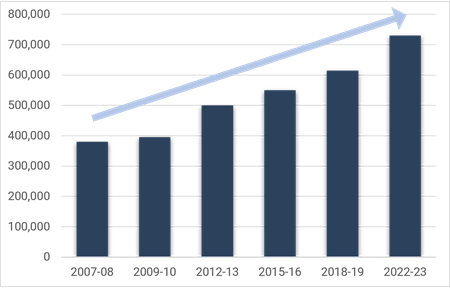
For CN, ‘Strong and Steady’ Pace for Grain Movement in Halfway Mark
Written by Carolina Worrell, Senior Editor
At the mid-point of the 2022-23 crop year, CN has been delivering “strong, consistent” results for grain movement in Western Canada with 15.2 million metric tons (MMT) of grain and processed grain products shipped, the Class I reported Feb. 10.
CN reports having set both weekly and monthly movement records through the fall and winter because of operational changes implemented this past spring and summer to “improve network fluidity and velocity.” The Class I says it has also been able to recover quickly from disruptions within the grain supply chain.
Many of these changes, CN says, are tied to the railroad’s 2022-23 Winter Plan, but the Class I has also executed strongly against its 2022-23 Grain Plan. “Improved collaboration and communications with customers, unit train slot planning, an increased focus on scheduled train service, and new capital investments,” have all played a part in CN’s success crop year-to-date, according to the railroad. Network velocity, measured as the average number of miles per day that a car travels, has been at its highest level since 2016.
This performance, CN says, comes despite the fact grain movement was limited in the first seven weeks of the crop year. Due to the 2021 Western Canadian drought, carry-in stocks as of August 1 were at record low levels. Once harvest of the new crop was underway, CN says it was able to “quickly ramp up grain shipment volumes, working closely with its customers to sync up its fleet deployment with forecast local demand.”
CN reports having notched its best-ever single month for Western Canadian grain movement in October at 3.3 MMT, beating the previous record by more than 120,000 metric tons. During the week of October 16, CN recorded its best-ever week of grain shipments from Western Canada at 810,000 metric tons, beating the previous record by more than 55,000 metric tons. These records, the railroad says, would not have been possible without “strong coordination and collaboration across the end-to-end supply chain, from farmers to grain companies, country elevators to export terminals, and CN’s team of dedicated railroaders.”
While terminal-related productivity issues in Vancouver reduced supply chain capacity in late October and early November, the supply chain on CN roared back through the balance of November. In the process, CN grain shipments reached 3.02 MMT for the month, just shy of the all-time November record. CN also recorded its second-best weekly grain shipment record of 798,000 metric tons the week of November 13. The following months continued the trend with December and January grain movement volumes totaling 2.55 MMT and 2.63 MMT, respectively, representing the second-highest volume ever recorded for each month.

October – November (metric tons)
At the halfway mark of the 2022-23 crop year, CN reports having shipped more than 15.2 MMT of grain and processed grain products from Western Canada.
“The company is well on its way to meeting or exceeding its guidance on expected grain shipment volume levels communicated in the 2022-23 CN Grain Plan,” the Class I said.
CN says it has also established its ability to meet growing demand for fall grain movement. Demand for grain movement from grain companies and farmers is at its peak in the fall for many reasons. The compound annual growth in CN grain shipment volumes in October and November, measured in average weekly grain shipment levels during that period, has “exceeded the compound annual growth in grain production in Western Canada,” the railroad said. Investment throughout the end-to-end supply chain—from farmers to grain customers and CN—have made results like these possible, the Class I added.



